In the previous article in this series on Outcome-Centric Selling® we addressed the importance of identifying and targeting our customer’s most pressing business issues – and now we are going to turn our attention to identifying and targeting our most valuable potential customers.
Unsurprisingly, these are the organisations that are most likely to be suffering from the issues we have chosen to target and are determined to do something about them. Our “ideal customer profiles” reflect the common characteristics of these organisations. But – as we’ll see – we must not restrict our thinking to the basic demographics of size, sector, and location.
As we’ll see, demographic attributes can only define the outer boundaries of our addressable target market – but they tell us very little about which specific organisations are actually most likely to want to buy from us. In fact, non-demographic factors turn out to be far more useful in predicting success – but we need to know what to look for.
Ideal Customer Profiles
Clearly-defined Ideal Customer Profiles are are essential to our marketing, outreach, and opportunity qualification programmes and help us to:
- Identify the organisations that are most likely to want to address the business issues we have chosen to target
- Establish the common characteristics of these “ideal customers” and how can we recognize them
- Equally important, they enable us to establish the common characteristics of organisations that are never likely to become good customers – so that we can avoid them
Not just demographics
There’s a key principle at play here: we need to think beyond the obvious demographic considerations and consider structural and cultural/behavioural (sometimes known as “firmographic”) indicators as well as their current priorities and initiatives:
- Demographic Factors: These basic factors include employees, revenue, users, vertical market, industry, function, location, and so on. They serve to define the boundaries of our target market, but tell us very little about which members of this market are actually likely to buy from us – or to become good customers
- Structural Factors: These factors include organisational structure, current systems, market focus, go-to-market model, market position and so on. They give us a better picture of which members of our target market are likely to be more promising
- Cultural/Behavioural Factors: These factors include the prospective customer’s appetite for innovation, their willingness to buy best-of-breed, their attitude to vendors, and so on. These factors are even more useful in determining which organisations are most likely to buy from us
- Current Priorities: These factors include the organisation’s current active projects, initiatives and priorities related to the business issues we are targeting. These factors are particularly relevant to determining whether they are likely to decide to act sooner, rather than later
Our ideal customers are a combination of all of the above factors:
- They demonstrate strong demographic, structural and cultural/behavioural fit – making them a good long-term prospect
- Their current priorities include the business issue(s) we have chosen to target – making them a good short-term prospect, plus
- They are accessible to our marketing, business development and sales organisations, and
- They are willing to engage with us, and
- They have the potential to become good (and profitable) long-term customers
A traffic light approach
It can be helpful to use a green-amber-red “traffic light” approach to each of these factors when assessing potential customers:
-
 GREEN: “Perfect Fit” – these organisations have the potential to become excellent customers
GREEN: “Perfect Fit” – these organisations have the potential to become excellent customers - AMBER: “Acceptable Fit” – these organisations, although not perfect, appear to be an acceptable fit and have the potential to become valuable customers
- RED: “Avoid/Disqualify” – organisations with these attributes are unlikely to ever become good customers and should be avoided or disqualified
We need to weigh up all the factors and make a balanced judgement as to whether the organisation or opportunity is worth pursuing – the presence of a single red flag may be enough to disqualify the organisation or opportunity.
Establishing our Ideal Customer Framework
A simple one-page framework can enable us to capture the specific demographic, structural, and cultural/behavioural characteristics, and priorities of our potential customers – allowing us to determine whether they are a perfect fit, an acceptable fit, or an organisation we would be better off avoiding or disqualifying.
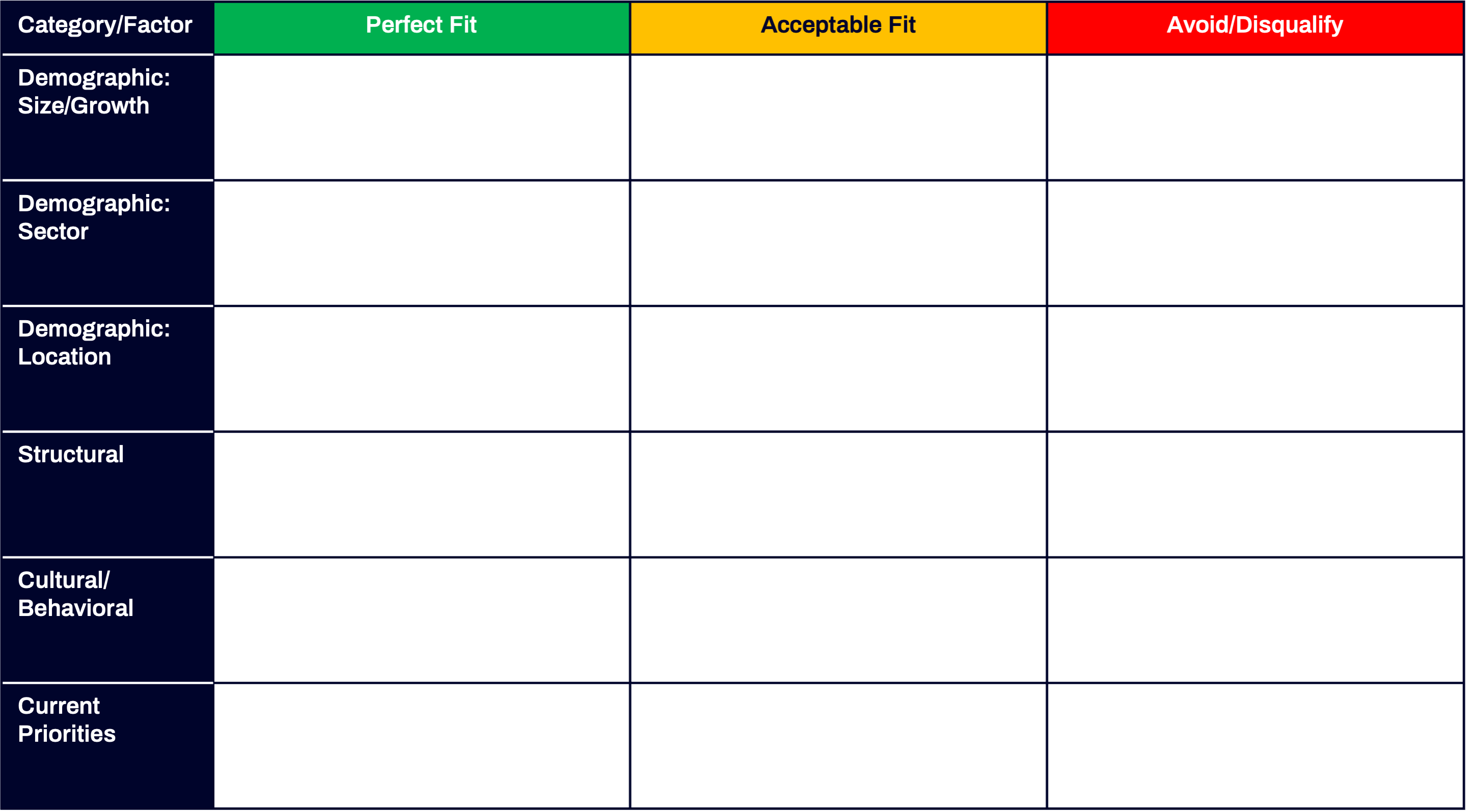
This framework can ensure that everyone in our organisation is “on the same page” – not just sales, but also marketing, business development, customer success and so on. It can help ensure we focus our energies on finding, winning, and retaining our most valuable customers – and avoid wasting our resources pursuing “prospects” that are never likely to result in good business.
Start by identifying the “perfect fit”
It’s usually best to start by defining the common attributes of our “perfect fit” customers. This involves:
- Identifying the handful of most important positive demographic, structural, and cultural/behavioral indicators associated with our most valuable customers, and
- Identifying any common corporate priorities and initiatives that are likely to focus attention on the issues we have chosen to target
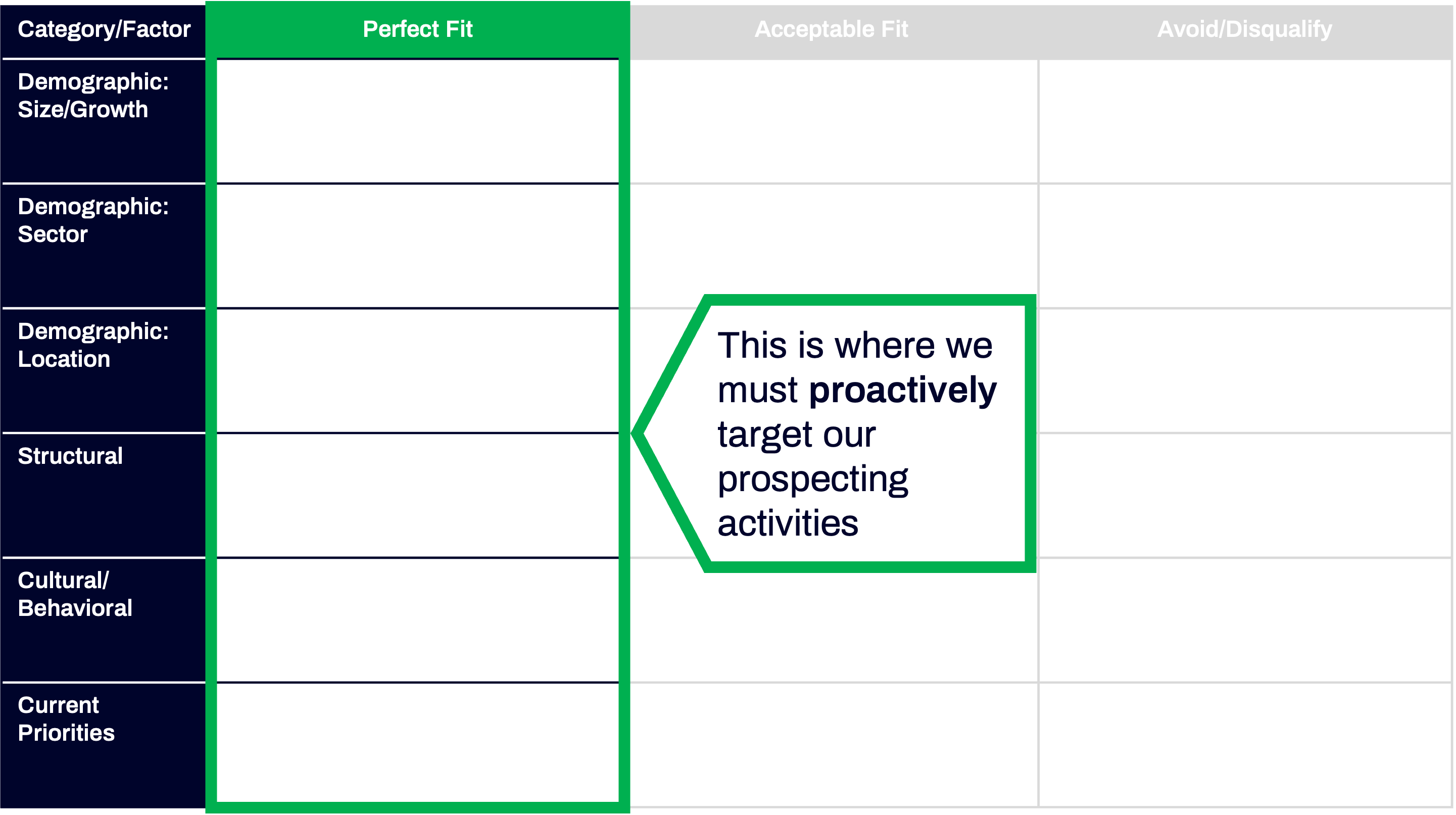
We should prioritise a program of proactive outreach to these organisations.
Then turn to the other extreme
We can then then turn our attention to the opposite of our “perfect fit” – the characteristics of the organisations we need to actively avoid or disqualify. This involves:
- Identifying the handful of most important negative factors that indicate an organisation is never likely to become a good customer
- Identifying any common corporate priorities that are likely to divert attention away from the issues we have chosen to target
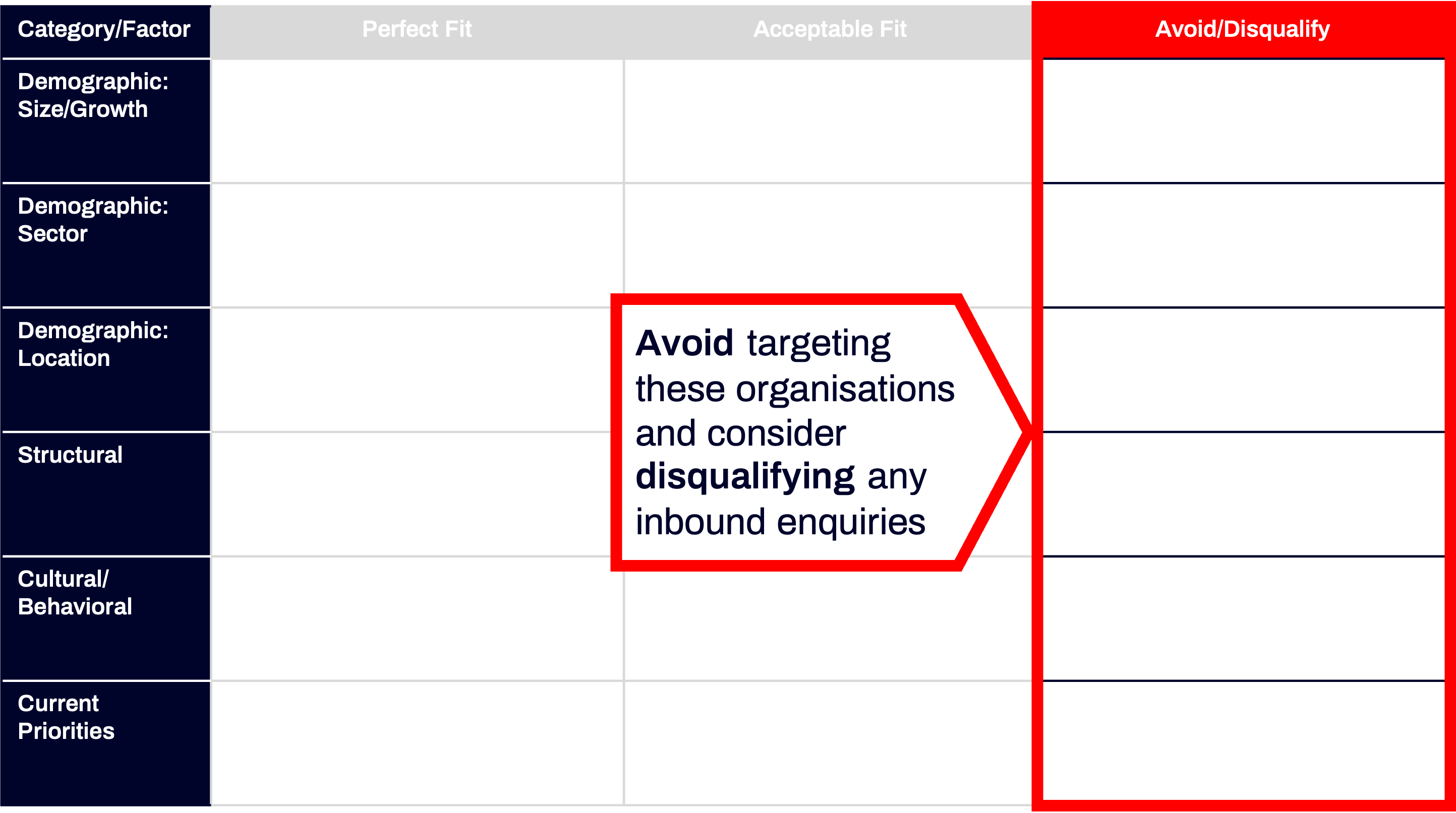
We should proactively disqualify or deprioritize these organisations and opportunities.
Then turn our attention to the middle
Having established the two extremes, we can then focus on the middle ground – the potentially “acceptable fit” organisations and opportunities that require further research and qualification. This involves:
- Learning more about their demographic, structural, and cultural/behavioural characteristics, as well as their most important priorities
- Proactively reaching out to the most promising members of this community
- When responding to enquiries from apparently “acceptable fit” prospective customers, carefully qualifying their level of interest and their likelihood of action
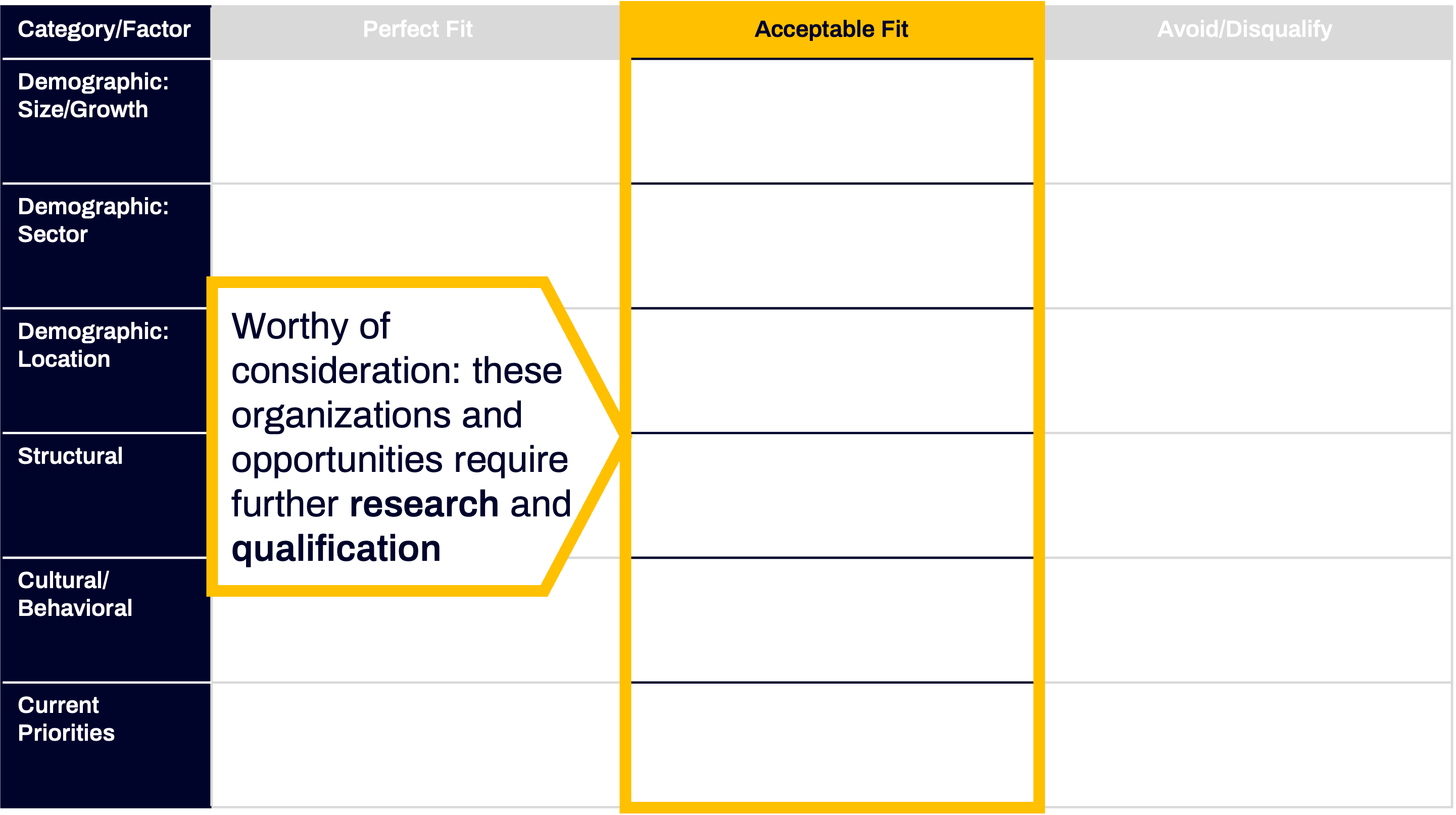
This understanding should then guide our positioning, messaging, prospecting and qualifying activities
Expect imperfection
There are few “100% perfect” target customers – and even fewer “100% perfect” sales opportunities. We need to weigh up all the factors and arrive at a balanced judgement – but also recognise that a single red flag can sometimes be enough to disqualify the customer/opportunity.
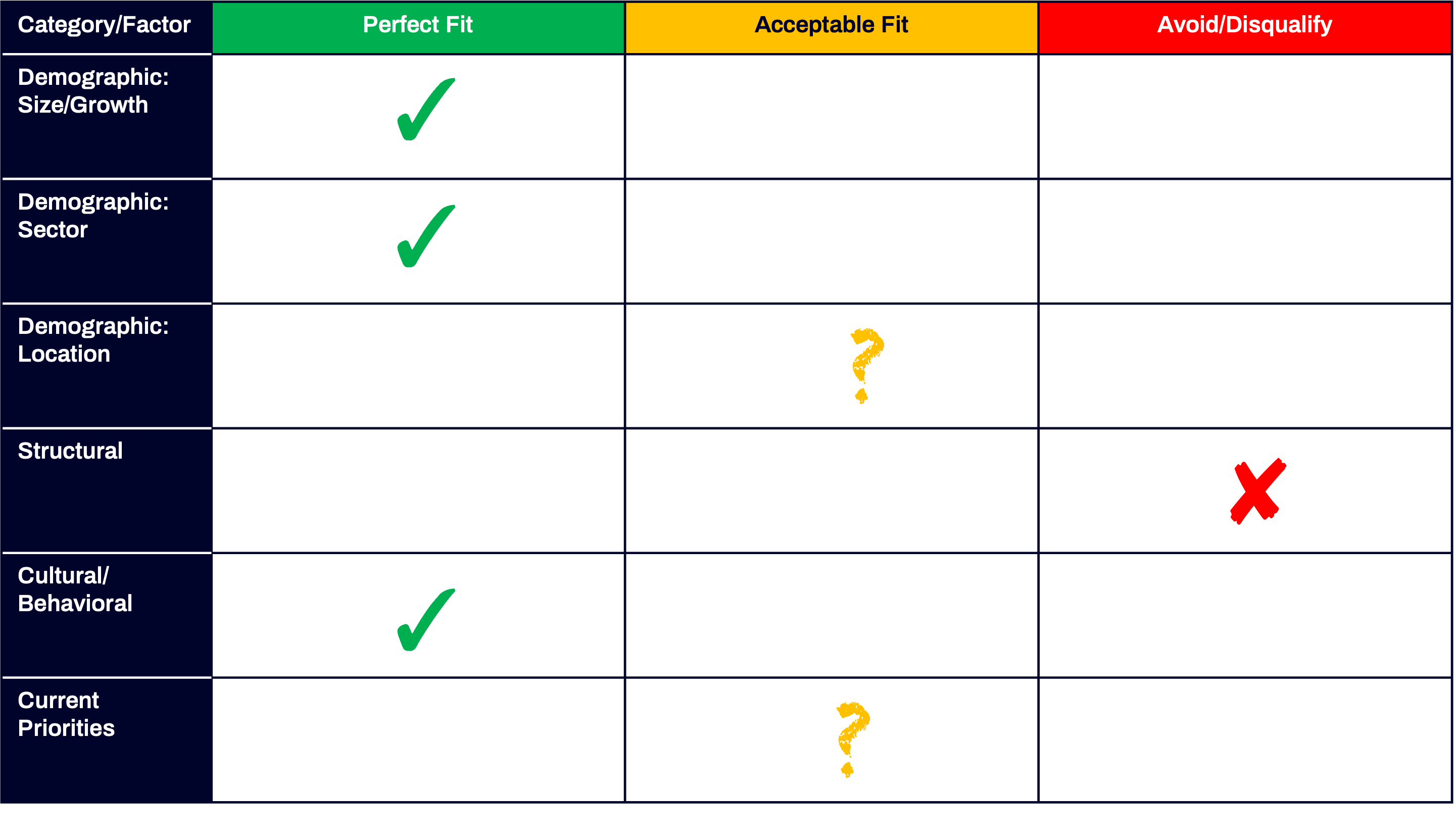
How and where we focus
Here’s an example of how Inflexion-Point targets our ideal customers and qualifies any inbound opportunities. We proactively target key roles in organisations that appear to be a “perfect fit”. We steer clear of targeting organisations with “avoid” characteristics and are likely to disqualify any enquiries from them – and we carefully qualify inbound enquiries from prospects who appear to be a potentially acceptable fit.
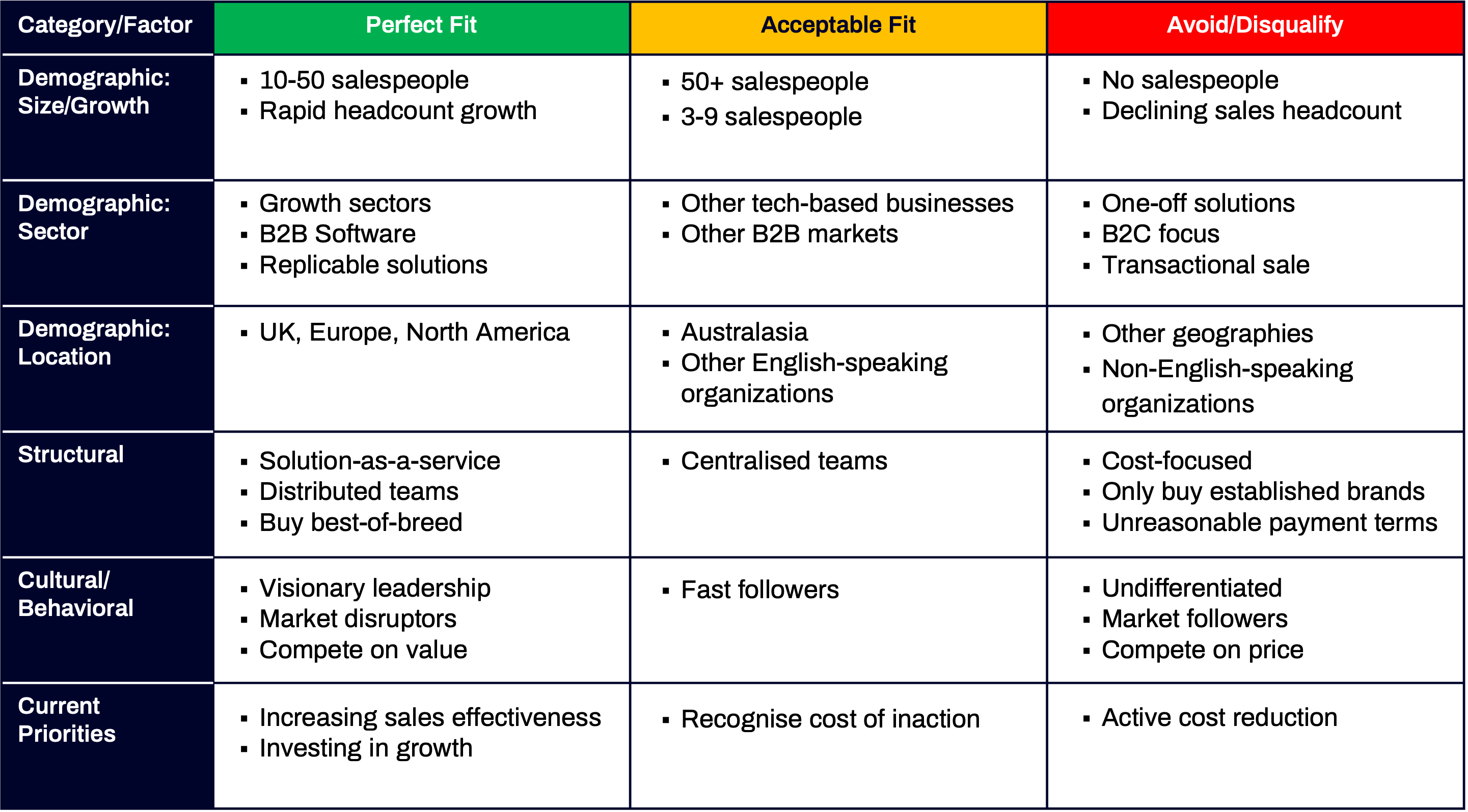
In summary
Here are the key takeaways from this article:
- We mustn’t stop at defining the boundaries of our target market: we must also seek out the hotspots with maximum potential
- We mustn’t restrict our thinking to demographics: we must also pay attention to common structural and cultural/behavioural factors and current priorities
- We must look for indicators of a perfect or acceptable fit as well as when to avoid or disqualify an organisation
- We must proactively target organisations that appear to be a perfect fit
- We must prioritize inbound enquiries from organisations that appear to be a perfect or acceptable fit
- We must be prepared to avoid or disqualify organisations that fit in the “red zone”
If you’d like to learn more (and download an editable version of the framework), please sign up for our academy course on the subject (or even better, subscribe to the whole academy).
I’ve said before that becoming outcome-centric is a journey, not a destination. There will always be ways in which we can increase the probability that every customer will recognise the value of our offerings in terms of the business outcomes we enable them to achieve. And the sooner we start the journey, the further we will progress down that path.
In the next article in this series, we’ll turn our attention to profiling the common characteristics of the key roles within our ideal customer organisations that are most likely to want to urgently deal with the issues we have chosen to target. If you haven’t already done so, you might in the meantime want to download our guide to Outcome-Centric Selling.
![]()



